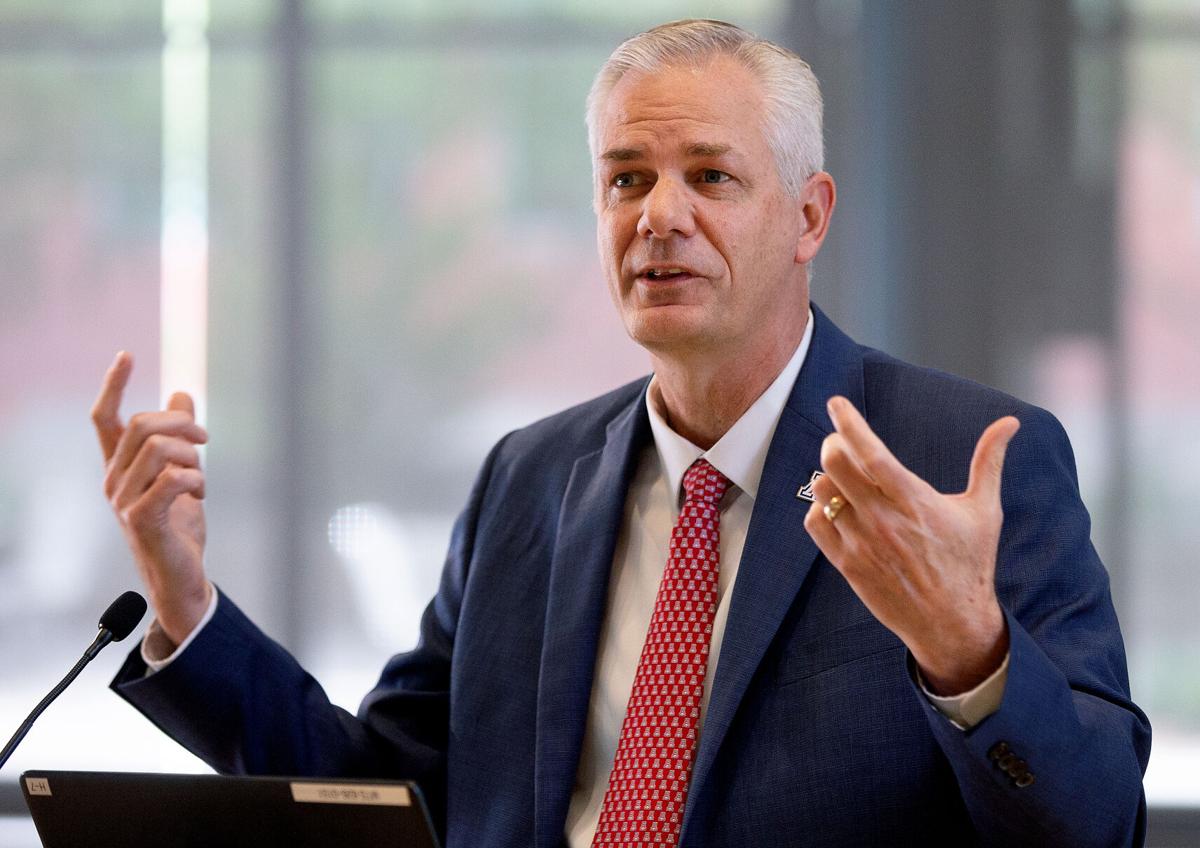University of Arizona leaders and the Arizona Board of Regents, “in retrospect,” should have understood “a little bit better” the financial trajectory the UA was on in recent years, Interim Chief Financial Officer John Arnold says.
Arnold, who also serves as ABOR’s executive director, told the board Thursday that a drop of unrestricted assets at the UA between 2021 and 2022 “should have raised some alarm bells for us.” He presented data on the university’s financials from last year before the financial crisis was unveiled.
It wasn’t until November 2023 that UA President Robert C. Robbins and former CFO Lisa Rulney informed ABOR about the financial issues at the university. Initially, they presented it as a “$240 million miscalculation.” Arnold was named interim CFO in December, and in January, he said the numbers instead turned out to show a $177 million deficit.
The CFOs at the UA, Arizona State University and Northern Arizona University were tasked with giving brief presentations to ABOR on Thursday afternoon about the fiscal year 2023 reports from their respective universities. Fiscal year 2023 ended June 30, 2023, five months before the UA’s financial issues were unveiled.
Arnold said he used the presentation to ask himself if there are better ways to predict possible financial crises.
“What were the clues in there and is there a better way, a better set of metrics we should be looking at?” he questioned. “I think that there probably are.”
One of the issues he found was that the UA presents cost and revenue in two different ways.
“We’re presenting cost on a per student basis,” he said. “Everything we’ve done on the revenue side is on a university basis. So, we haven’t, in these metrics, really drawn a good comparison.”
“That causes some misses of what was going on inside the university,” he said.
In 2021, the UA’s days’ worth of cash on hand were “really, really high,” at 173 days, Arnold noted.
“But there was a significant drop between 2021 and 2022,” he said. In 2022, the university had 149 days’ cash on hand. That’s a drop of about $45 million.
Part of the reason cash on hand was so high in 2021 was because the UA took deferred payroll taxes and a debt holiday because of the COVID-19 pandemic, Arnold said.
Additionally, ABOR and UA leaders weren’t “alarmed by” the drop in days’ cash on hand in 2022 because the university was in the middle of investing in its strategic plan.
“In retrospect, we probably should have understood a little bit better what was going on between fiscal (year) 2021 and fiscal (year) 2022,” Arnold said.
The presentation wasn’t all bad news, however. The university’s total revenue increased between 2019 and 2023. In 2019, the UA brought in a total of $2.19 billion in revenue. That jumped to $2.66 billion in 2023.
Despite the increase in revenue, the UA was giving too much in financial aid, Arnold said, something that has been cited as a major cause of its financial issues.
While the amount the UA is pulling in from tuition and fees has increased — from $891 million in 2019 to $1.086 billion in 2023 — the scholarship allowance as a percentage of that gross tuition and fees has grown disproportionately.
It climbed from 26% in 2019 to 34% in 2023, Arnold said.
“Perhaps what should have been alarming to us in this chart is the scholarship allowance as a percentage of gross tuition and fees,” he said. “We’ve seen that climb from 26% up to 33% in 2022 and 34% in 2023, which suggests that our per student revenue was likely not growing as quickly as total revenues.”
In response, the UA is drastically reducing the amount of merit aid for out-of-state students and, starting for students admitted next year, ending its four-year tuition guarantee.
There were a few things Arnold and his team simply couldn’t explain.
One is the spendable cash investment and operating expenses ratio, which went up in 2022 when days’ cash on hand went down.
“I’ve had a team of people trying to explain to me why the number went up in 2022 when the days in cash went down in 2022,” he said. “I still don’t know the answer to that.”
He has a similar issue in understanding why the operating margin ratio spiked in 2022: “Not a clear understanding to me in what’s really going on here,” he noted to the board.
Despite his concerns, Arnold stated that “the university is still in a strong cash position.”
“We’d like it to be stronger and we will work towards making it stronger,” he said. “This is the reason why universities have cash reserves, so they can self-finance through hiccups.”
Get your morning recap of today's local news and read the full stories here: tucne.ws/morning





